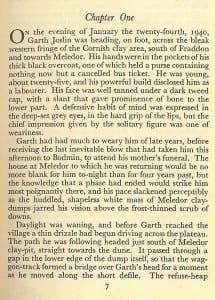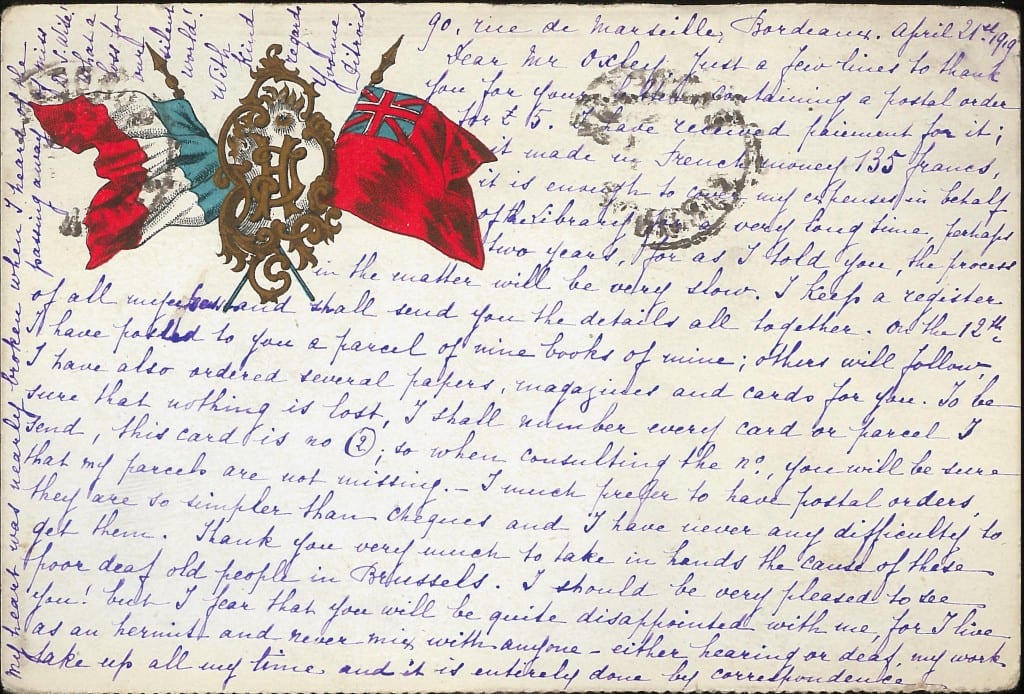Jack Clemo, “prydyth an pry”, deaf-blind poet and novelist (1916-1994)
By H Dominic W Stiles, on 4 March 2016
 The Cornish writer Reginald John Clemo, commonly called Jack, was born on born March 11th, 1916, near St. Austell in Cornwall. His mother Eveline Polmounter, daughter of a Methodist preacher, was pious, “a dreamy, sensative girl, naive, steeped in worthy religious books and cheap romantic novels, with little interest in the lives of the clay labourers beyond the farm” (Magnusson, p.12). His father Reginald, belonged to a family that had a bad reputation but were very poor, working as clay labourers (ibid). He liked to dress up, and he joined the chapel choir as he loved to sing, and there he came to know Eveline. In 1909 Reggie decided to try his fortune in the Montana copper mines. He returned after three years, having spent what he had earnt, and they married in 1913 (ibid p.14). Their first child died as a baby, but then when war broke out Reggie went to work at a Woolwich munitions factory, then Devonport dockyard. Shortly after Jack was born his father was sent to work in the navy, and he died on the 23rd of December, 1917, when the ship he served on as a Stoker, 2nd Class, H.M.S. Tornado, was mined off Rotterdam (not torpedoed as Magnusson says) (Spinks, see * below).
The Cornish writer Reginald John Clemo, commonly called Jack, was born on born March 11th, 1916, near St. Austell in Cornwall. His mother Eveline Polmounter, daughter of a Methodist preacher, was pious, “a dreamy, sensative girl, naive, steeped in worthy religious books and cheap romantic novels, with little interest in the lives of the clay labourers beyond the farm” (Magnusson, p.12). His father Reginald, belonged to a family that had a bad reputation but were very poor, working as clay labourers (ibid). He liked to dress up, and he joined the chapel choir as he loved to sing, and there he came to know Eveline. In 1909 Reggie decided to try his fortune in the Montana copper mines. He returned after three years, having spent what he had earnt, and they married in 1913 (ibid p.14). Their first child died as a baby, but then when war broke out Reggie went to work at a Woolwich munitions factory, then Devonport dockyard. Shortly after Jack was born his father was sent to work in the navy, and he died on the 23rd of December, 1917, when the ship he served on as a Stoker, 2nd Class, H.M.S. Tornado, was mined off Rotterdam (not torpedoed as Magnusson says) (Spinks, see * below).
| Cause of Death: | Killed or died as a direct result of enemy action |
|---|---|
| Official Number Port Division: | K.38321 (Dev) |
| Death Date: | 23 Dec 1917 |
| Ship or Unit: | HMS Tornado |
| Location of Grave: | Not recorded |
| Name and Address of Cemetery: | Body Not Recovered For Burial |
| Relatives Notified and Address: | Widow: Eveline, Gonnanarris Slip, St Stephens, Nr Grampound Rd, Cornwall |
At the age of 18 months, Jack was able to recite the Lord’s Prayer, and aged four he was “reading vigorously” (Magnusson, p.16). When he was five he had his first attack of blindness, diagnosed as iritis, and it took a year to go, but it changed Jack to a withdrawn introspective child (ibid p.17-18). He started school but hated it, though he excelled at writing, and religious study. He had a further episode of blindness when he was thirteen, which made him even more inward looking, but at the same time became inspired to write after meeting a girl called Evelyn at a cousin’s wedding. She took it on herself to look after him, “stroking his hair and whispering softly throughout the meal. The effect on a boy whose senses and emotions had been so starved was electric. That day was born an obsession that that was to haunt his imagination for a long time to come.”
He began to write articles for Netherton’s Almanack, and pursued Evelyn until she ignored him, eventually sending back all his letters. He fell into despair, and as he approached his nineteenth birthday became increasingly deaf (ibid p.38). Although he had always been spiritual, at around this time he experienced a conversion, though not connected with any traditional religious group.
His first novel, Wilding Craft, was finallly published in 1948. Here is a short excerpt to give something of his style –
When all was quiet and he knew Irma too must be lying up there in all her lovliness, awaiting sleep, Garth leaned over the sofa and noiselessly drew back the curtain from the window. Moonlight streamed into the room, for the the moon, just past full, was riding up behind Trethosa, the tree-tops cutting upon its silvery shrunken disc like black veins, unmoving, while shadows all over the valley and the clay ridges were becoming magical, the triangular shade of sand-dumps broken upon the folds of the pits, and the shade of drying-sheds and tanks groping out over the Fal and the marshland, over the first war-time instalment of flowers, insects, microscopic eggs and amphibian life. Hardly a cloud up there among the stars, and no marauding apparition below. (Wilding Graft, p.278-9)
He won an ‘Atlantic Award for Literature’ worth £100 for this novel (Magnusson p.71). It was a Rockefeller prize that helped young writers whose careers had been disrupted by the war (one winner being P.H.Newby, the first Booker winner).
In 1951 his poetry collection , The Wintry Priesthood, won a £100 Festival of Britain poetry prize. Magnusson quotes this poem, The Two Beds, which shows his combination of the erotic-mystical and industrial, and if that sounds strange do follow up the links at the bottom of this page –
…you never saw
The clay as I have seen it, high
On the bare hills, the little breasts
So white in the sun, all the veins running white
Down to the broad womb with its scars.
And the scars meant, beyond fertility,
Purgation – symbol of the stained rock,
And the live water searching, cooling
Along the bare sinew; and then the heat,
The brief heat beyond the body; and at last
The cup for the new wine. (But that is yonder
And this is faith). So I had the open view,
While you groped in cramped seams, found no heavenly clue.
Clemo’s sight deteriorated iin the 1950s and by 1955 he was blind.
Spinks says of Clemo,
His early poetry is infused with an erotic view of the barren clay landscape of his home and God’s just demand for the surrender of the personal soul. He praised the industrial invasion of the natural world as God’s grace claiming his own. Though he derided nature, his verse has a haunting beauty of expression and the challenge of a personal, honest voice.
Having had a correspondance with Ruth Grace Peaty, he finally achieved a long held desire, when he married her in 1968. In 1970 he was made ‘prydyth an pry’ or ‘Poet of the Clay’ at the Gorsedd – Cornwall’s unofficial national assembly.
He died in 1994 and is buried in Weymouth. An archive of his manuscripts and papers is held at the University of Exeter – see link below. In 2005 the cottage he had lived in for much of his life was destroyed by the Goonvean quarry. Though we might consider this modern vandalism, in the light of his ideas of industry and nature mentioned above, one wonders whether he might have thought this a sort of poetic justice, appropriate for the landscape he knew so well.
 Magnusson, Sally, Clemo, a love story. 1986, Tring.
Magnusson, Sally, Clemo, a love story. 1986, Tring.
Michael Spinks, ‘Clemo, Reginald John (1916–1994)’, Oxford Dictionary of National Biography, Oxford University Press, 2004; online edn, Jan 2011 [http://www.oxforddnb.com/view/article/54814, accessed 2 March 2016]
http://www.tolstoytherapy.com/2014/06/keeping-poets-alive-jack-clemo-cornwall.html
http://www.sense-of-place.co.uk/Rescorla/clemo.htm
*Marine War graves Roll -TNA Series: ADM 242/7; Scan Number: 0787
A web search will bring up more interesting items.
 Close
Close



